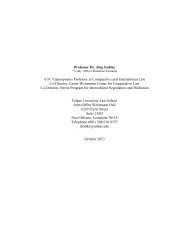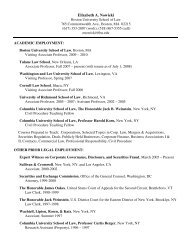environmental - Tulane University Law School
environmental - Tulane University Law School
environmental - Tulane University Law School
You also want an ePaper? Increase the reach of your titles
YUMPU automatically turns print PDFs into web optimized ePapers that Google loves.
NEW COURSES<br />
2013 debuted two new courses in the<br />
E and E Program, one entitled OUTSIDE<br />
THE BOX explored the relationship of<br />
<strong>environmental</strong> law with everything else,<br />
ie Religion, Risk, Science, Property,<br />
Population, you name it, it came up.<br />
The second was an LLM SEMINAR<br />
focused on the overlap of Energy and<br />
the Environment with Sustainable<br />
Development and with International and<br />
Comparative <strong>Law</strong>, companion disciplines<br />
in the <strong>Tulane</strong> Masters programs.<br />
We opened class with greetings in new<br />
languages each time, and took it from<br />
there.<br />
Both seemed to work. The more one<br />
mixes in this field the better it seems to<br />
turn out.<br />
Front Row (L-R) Zumrud Msaeva, D’Ann Penner, Huo<br />
Alberto Wood Nunez; Back Row (L-R): Mukesh Kumar,<br />
Francis Yancy, Professor Houck, Daniel Collier, Roberto<br />
Sepulveda Olavarria<br />
Institute for Water<br />
<strong>Law</strong> and Policy<br />
Over the past year the Institute submitted<br />
briefs to the Supreme Court on<br />
water-related cases, supported the work<br />
of the Louisiana Water Resources Commission<br />
and the Louisiana <strong>Law</strong> Institute<br />
(both of which count the Institute’s<br />
director as a member), and tracked damage<br />
issues from the Deep Water Horizon<br />
oil spill. But nothing was more important—or<br />
challenging—than helping to<br />
craft a comprehensive Urban Water Plan<br />
for metropolitan New Orleans.<br />
The new strategy was two years<br />
in the making, but way overdue for a<br />
region facing profound subsidence and<br />
seal level rise challenges. It has been well<br />
received but raises questions, including<br />
how its estimated $6.2 billion cost will<br />
be met. As it turns out, while the cost is<br />
a big number it is actually not so big as<br />
the status quo. The plan estimates that<br />
investing in its recommended actions,<br />
particularly those that slow the region’s<br />
subsidence rates, would produce over<br />
$10 billion dollars in savings: when soils<br />
don’t sink, pipes don’t break, streets<br />
don’t crumble, and foundations don’t<br />
shift the way they now do, recurringly.<br />
More savings come from flood insurance<br />
rates. On the income side, treating water<br />
as a community asset opens a wealth of<br />
possibilities for stormwater retention and<br />
water-side urban renewal. Real estate<br />
The plan estimates<br />
that investing in its<br />
recommended actions,<br />
particularly those that<br />
slow the region’s<br />
subsidence rates, would<br />
produce over $10<br />
billion dollars in saving…<br />
values soar. The tax base follows suit.<br />
Canoes and excursions appear. Everyone<br />
wins.<br />
The plan was sponsored by Greater<br />
New Orleans Inc. and compiled by a<br />
team led by the architectural firm, Waggonner<br />
and Ball. The <strong>Tulane</strong> Institute’s<br />
director Mark Davis and research assistants<br />
Harry Vorhoff and Fredric Augonnet,<br />
TLS 2013, were also members of<br />
the planning team.<br />
4 TULANE ENVIRONMENTAL LAW NEWS | FALL 2013





